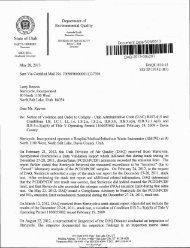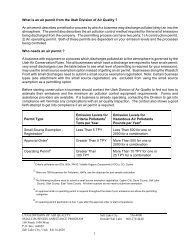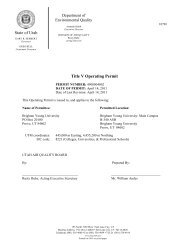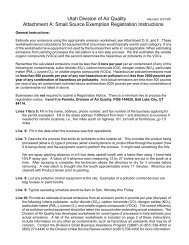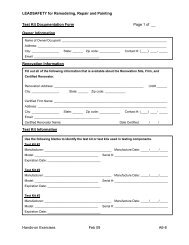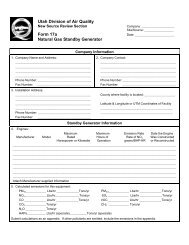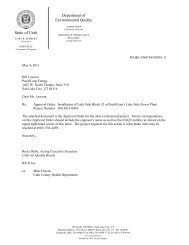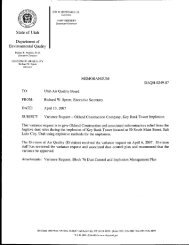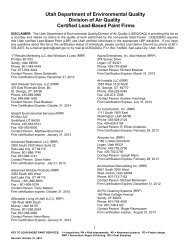Air Emissions Printer Worksheet - Summary (Offset Lithography)
Air Emissions Printer Worksheet - Summary (Offset Lithography)
Air Emissions Printer Worksheet - Summary (Offset Lithography)
You also want an ePaper? Increase the reach of your titles
YUMPU automatically turns print PDFs into web optimized ePapers that Google loves.
<strong>Air</strong> <strong>Emissions</strong>Company Name:Facility Name:Emission <strong>Summary</strong><strong>Printer</strong> <strong>Worksheet</strong> - <strong>Summary</strong>(<strong>Offset</strong> <strong>Lithography</strong>)ABC CompanyWest BranchDate: 11/6/2002ParticulateMaterialPM10VolatileOrganicCompoundsVOCsInk Emission 0.07Coatings 1.21Fountain Solutions 3.10Wash Solutions 3.30SulfurDioxideSO2NitrogenOxidesNOxCarbonMonoxideCOStand-by GeneratorTotal Tons/Year 0.00 7.69 0.00 0.00 0.00Basic InstructionsThese calculation sheets use Microsoft Excel, so you will need the Microsoft Excel program to use these spreadsheets.Typing in the cell can delete everything in the cell; number or text or equation, it is good practice to create a mastersheet and then copy/rename a working file.Step 1Step 2Fill in the company, facility name and identifying information in the shaded boxes. The information will be copied tothe attached sheets (Tabs).The emissions for the ink emissions, coatings, fountain solutions, and wash solutions are calculated from theattached sheets (the tabs at the bottom of this page), Ink <strong>Emissions</strong>, Coatings, Fountain and Wash Solutions.You enter the information on the attached sheets and the emission results for VOCs are copied by the program tothis front page. Do not forget to attach all the calculation sheets to the summary when submitting the emissionestimate for permitting. Also remember to include the hazardous air pollutant (HAPs) calculation.If you have other emission points add the equipment to this table, and attach the calculation.The text on the attached sheets details the calculations, the Excel program will do the calculation for you, thedetails are included as an explanation of how the calculation is performed so you could do the calculation manually.Step 3If you have other equipment with emissions you need to calculate these emissions and add them to this sheet.Step 4When you have completed all the calculations for all the emission points at the business, print out all the sheetsand attach them to your submittal.Note: To print the whole workbook, chose the 'entire workbook' button on the 'print what' box.
<strong>Air</strong> <strong>Emissions</strong>Company Name:Facility Name:ABC CompanyWest Branch<strong>Printer</strong> <strong>Worksheet</strong> - InkDate: 11/6/2002Ink <strong>Emissions</strong> - Volatile Organic Compounds (VOCs)Ink(A)Press Type:Non-Heatsetor Heatset(B)ReleaseFactorVolatile OrganicCompound ContentFraction(15%=0.15)(D)Poundsper Year(E)<strong>Emissions</strong>(lbs/year)(F)(C)Black Heatset 80% 0.15 1000 120.00Red NonHeatset 5% 0.25 2000 25.00Total VOC <strong>Emissions</strong> in Pounds/Year Box X 145.00Total VOC <strong>Emissions</strong> in Tons/Year Box Y 0.07Step 1Categorize your ink usage in Column A of the table.Note: Your product supplier may have a program that estimates volatile organic compounds (VOCs) in hisproducts, so check with him to see if he does, filling out these tables will be easier. If you use supplier numbersmake sure they include the release factor.Step 2Step 3Step 4Enter the press type, Non-Heatset or Heatset, in Column B. Click on the box and then the down arrow to displaythe choices. The press type determines the release factor in Column C, the release factor is automaticallyassigned by the program after the press type is choosen. For non-heatset printing the release factor is 0.05, forheatset printing the release factor is 0.80. The release factor will automatically be input on to the sheet after youenter the press type. The release factors comes from the EPA document : Control Techniques Guideline for<strong>Offset</strong> <strong>Lithography</strong>, November 1993.From the Material Safety Data Sheet (MSDS) input the volatile organic content (VOC) in percent by weight. Enterthe fraction, 0.15 or 0.35, Column C.Estimate the pounds per year of products that you use on an annual basis in Column E. This can be estimated byrecording what you use in an average month and then multiplying by 12 to convert to an annual basis.Step 5Step 6<strong>Emissions</strong> are equal to the Release Factor times the fraction of VOCs per pound times the Pounds per year, F =C x D x E, enter the number in Column F.Add all the results in column F for a total in Box X. Divide the total in Box X by 2000 to convert pounds to tons peryear, Y=X/2000, enter number in Box Y.The totals will automatically be copied to the front sheet, <strong>Emissions</strong> <strong>Summary</strong>.Do not include exempt VOC's like Methylene Chloride, 1,1,1-Trichloroethane, Acetone, or Methyl Acetate. Seethe definition of "Volatile Organic Compound (VOC)" as defined in 40 CFR Subsection 51.100(s)(1).Remember volatile organic compounds are often hazardous air pollutants, so include an estimate of thehazardous air pollutants in the ink used at the business.
<strong>Air</strong> <strong>Emissions</strong><strong>Printer</strong> <strong>Worksheet</strong> - CoatingsCompany Name: ABC CompanyFacility Name: West BranchDate: 11/6/2002Coatings <strong>Emissions</strong> - Volatile Organic Compounds (VOCs)Coatings(A)ReleaseFactor(B)Pounds orGallonsPer Year(C)Volatile OrganicCompoundsFraction(15%=0.15)or lbs-VOC/gal(D)<strong>Emissions</strong>Lbs-VOCPer Year(E)Varnishes 5% 200 Pounds 0.35 3.5UV 100% 250 Gallons 8.5 2125Water-Based 100% 150 Gallons 2 300Total VOC <strong>Emissions</strong> in Lbs/Year Box X 2428.5Total VOC <strong>Emissions</strong> in Tons/Year Box Y 1.21Step 1Step 2Step 3Step 4Step 5Step 6Categorize your product usage in Column A of the table.Note: Your suppliers may have a program that estimates volatile organic compounds in his products, so check withthem to see if they do.The release factor, Column B, for coatings is determined from the coating type. Click on the box and then the downarrow to display the choices. Varnishes applied as an overprinting coating have a 5% release factor. Water-basedor UV coatings have no reduction of the VOCs released or 100% release factor. Note: Varnishes are typically inpounds so the units in Column C will automatically be listed as pounds and the VOCs are estimated using a fraction,ie 15%= 0.15. All other coatings will automatically be listed in gallons and the VOCs are estimated by pounds pergallon, ie 7 lbs/gal. The release factors comes from the EPA document : Control Techniques Guideline for <strong>Offset</strong><strong>Lithography</strong>, November 1993.Estimate the total pounds or gallons of coatings products used (use Column A as a guideline for categories) thatyou use on an annual basis. This can be estimated by recording what you use in an average month and thenmultiplying by 12 to convert to annual basis. Enter the pounds or gallons in Column C.Enter the typical VOC content in pounds per gallon (for 100% Release Factor) or percent by weight (for 5% ReleaseFactor) for the coatings products in Column D. The VOC content can be obtained from your Material Safety DataThe coatings emission will be calculated by multiply release factor (B), the pounds or gallons per year (C), and theVOCs (D). E = B x C x D.Box X is the addition of Column E.Box Y is Box X divided by 2,000 to convert pounds to tons, Y= X / 2000.The totals will automatically be copied to the front sheet, <strong>Emissions</strong> <strong>Summary</strong>.Remember : Volatile organic compounds are often hazardous air pollutants, so include an estimate of thehazardous air pollutants in the inks, fountain solutions, and cleaning solutions used at the business.
<strong>Air</strong> <strong>Emissions</strong><strong>Printer</strong> <strong>Worksheet</strong> - Fountain SolutionsCompany Name:Facility Name:ABC CompanyWest BranchDate: 11/6/2002Fountain Solution <strong>Emissions</strong> - Volatile Organic Compounds (VOCs)Etch/ConcentrateAlcohol/Substitute(A)Fountain Solution ConcentrateFountain Solution AdditiveVolatile OrganicCompoundslbs-VOC/gal(B)GallonsPer Year(C)<strong>Emissions</strong>Lbs-VOCPer Year(D)5.8 1000 58002 200 400Total <strong>Emissions</strong> in Lbs/Year Box X 6200Total <strong>Emissions</strong> in Tons/Year Box Y 3.1Step 1Step 2List your product usage in Column A of the table, this will make the emission estimate easier.Note: Your suppliers may have a program that estimates volatile organic compounds in his products, so check withthem to see if they do.Enter the typical VOC content for these products in Column B. Use the material safety data sheets (MSDS) for thisinformation. No retention or release factors have been established for VOCs or HAPs in fountain solutions.Step 3Estimate the total gallons of products that you use on an annual basis. Include all the chemicals you use at yourbusiness. This can be estimated by recording what you use in an average month and then multiplying by 12 toconvert to annual basis. Enter the gallons in Column C.Step 4Step 5Multiply the gallons per year in Column C by the pounds of VOCs per gallon that is given in Column B. D= B x C,enter the number in Column D.Add the numbers in column D and enter total in Box X. Divide Box X by 2,000 to convert pounds to tons, Y= X /2000, enter the number in Box Y.The totals will automatically be copied to the front sheet, <strong>Emissions</strong> <strong>Summary</strong>.Remember volatile organic compounds are often hazardous air pollutants, so include an estimate of the hazardousair pollutants in the paints, solvents and other chemicals used at the business.
<strong>Air</strong> <strong>Emissions</strong><strong>Printer</strong> <strong>Worksheet</strong> - Wash SolutionsCompany Name:Facility Name:ABC CompanyWest BranchDate: 11/6/2002Wash Solutions <strong>Emissions</strong> - Volatile Organic Compounds (VOCs)Wash Solutions(A)ReleaseFactor(B)Volatile OrganicCompoundslbs-VOC/gal(C)GallonsPer Year(D)<strong>Emissions</strong>Lbs-VOCPer Year(E)Blanket Wash 100% 6 100 600Roller Wash 100% 6 1000 6000Total VOC <strong>Emissions</strong> in Lbs/Year Box X 6600Total VOC <strong>Emissions</strong> in Tons/Year Box Y 3.3Step 1Step 2Step 3Step 4Categorize your product usage in Column A of the table. Include all the chemicals you use at yourbusiness.Note: Your suppliers may have a program that estimates volatile organic compounds in his products, soh k ith th t if th dThe release factor, Column B, for wash solutions is determined from the vapor pressure of the washsolution. Click on the box and then the down arrow to display the choices. If the vapor pressure is lessthan 10 mm Hg@20C, then you can reduce the VOC emissions for the wash solution by 50%. If thevapor pressure is more than 10 mm Hg@20C, there is no reduction of the VOCs released. Thisrelease factor is from the EPA document: Alternative Control Techniques Guideline for <strong>Offset</strong><strong>Lithography</strong>, June 1994 (EPA 453/R-94-054).Enter the typical VOC content for the products in Column C. Look on the material safety data sheets(MSDS) for this information.Estimate the total gallons of products (use Column A as a guideline for categories) that you use on anannual basis. This can be estimated by recording what you use in an average month and thenmultiplying by 12 to convert to annual basis. Enter the gallons in Column C.Step 5Multiply the gallons per year in Column C by the pounds of VOCs per gallon that is given in Column B.D= B x C, enter the number in Column D. The VOC content per gallon of coating can be obtained fromyour Material Safety Data Sheets (MSDS), if the content is not listed in Column B.Step 6Add the numbers in column D and enter total in Box X. Divide Box X by 2,000 to convert pounds totons, Y= X / 2000, enter the number in Box Y.The totals will automatically be copied to the front sheet, <strong>Emissions</strong> <strong>Summary</strong>.Remember : Volatile organic compounds are often hazardous air pollutants, so include an estimate ofthe hazardous air pollutants in the inks, fountain solutions, and cleaning solutions used at the business.
<strong>Air</strong> <strong>Emissions</strong>Company Name:Facility Name:<strong>Printer</strong> <strong>Worksheet</strong> - Hazardous <strong>Air</strong> PollutantsABC CompanyWest BranchDate: 11/6/2002Hazardous <strong>Air</strong> Pollutants Emission <strong>Worksheet</strong>Chemicals UsedEthylene glycolInsert HAP nameInsert HAP nameInk, Coatings,Fountain Solutions,Wash Solutions(A)ReleaseFactor(B)GallonsPer Year(C)PoundsPerGallon(D)PoundsPer Year(E)Fraction(15%=0.15)(F)PoundsPer Year(G)Fraction(15%=0.15)PoundsPer YearFraction(15%=0.15)Fountain Solution 100% 200 8 1600.00 0.3 480.00 0.00 0.00PoundsPer YearSub -Total = 480.0Sub -Total = 0.0Sub -Total = 0.0Grand Total =480 pounds/year (Combined HAPs)0.24 tons / year
<strong>Air</strong> <strong>Emissions</strong><strong>Printer</strong> <strong>Worksheet</strong> - Hazardous <strong>Air</strong> PollutantsHazardous <strong>Air</strong> Pollutants Emission <strong>Worksheet</strong>InstructionsStep 1Step 2Step 3Enter the different products in Column A of the table; Inks, Coatings, Fountain Solutions, Cleaning Solutions. The products listed should be the sameones listed on the previous sheets, if they contain hazardous air pollutants.Note: Typically there are no HAPs in inks, check your MSDS.The release factor, Column B, for the different chemicals used. The release factor used here should be the same number used on the previous sheets,see those sheets for a detailed explanation of the factors listed.Estimate the total gallons of product that you use on an annual basis for each designated product category and fill in the number in Column C. Thegallons per year can be estimated by recording what you use in an average month and then multiplying by 12 to convert to annual basis.Step 4The pounds per gallon in Column D can be determined from your representative MSDS for the product category. If the specific gravity (S.G.) is giveninstead, use the following formula to calculate pounds per gallon: S.G. X 8.3 lbs/gal. The S.G. will be in the range of 0.8 to 1.3. For example, mostsolvents are less than 1.0 since they are less dense than water. Specific gravity is the density of the product compared to water weighting 8.3 lbs/gallon.Step 5Step 6Step 7Step 8Multiply the gallons per year in Column C by the pounds per gallon given in Column D. C x D = E, fill in the number in Column E.Using your representative MSDS, compare all the chemicals listed on the MSDS to the list of 188 hazardous air pollutants (HAPs) list. List all the HAPsand percent by weight in the space provided in Column F. Note: Copy the HAP name from the list so you don't have to type out the chemical name. Ifthe MSDS gives a range of 10-20% for a chemical, use the midpoint of 15%. Convert the percentage (15%) to a fraction (.15) and enter in Column F.Keep in mind that an MSDS lists many chemicals that are not HAPs.To determine the pounds per year for each HAP in a product category, multiply the pounds per year in Column E by the fraction in Column F. Enter thenumber in the space provided in Column G.Add the pounds per year for each HAP in Column G and enter the total at the bottom of the table. Enter the pounds per year for all HAPs for a GrandTotal. If you have more HAPs then provided add columns for more HAPs by selecting, copy and paste.
<strong>Air</strong> <strong>Emissions</strong><strong>Printer</strong> <strong>Worksheet</strong> - Hazardous <strong>Air</strong> PollutantsHazardous <strong>Air</strong> Pollutants Emission <strong>Worksheet</strong>List of HAPS Most Common to the Lithographic Printing Industry.From the <strong>Printer</strong>s' National Environmental Assistance Center (www.pneac.org)The following list of HAPs can be found in materials used in sheet fed printing and is provided to assist in the identification of HAPs. A complete list ofHAPs is included in this folder and the user needs to compare it with the MSDS chemicals.HAPCAS#ProductCumene 98-82-8 Blanket conditionerBlanket/Roller WashEthyl Benzene 100-41-4 Metering Roller CleanerBlanket/Roller WashEthylene glycol 107-21-1 Fountain Solutionn-Hexane 110-54-3 Spray AdhesiveNapthalene 91-20-3 Blanket/Roller WashMethanol 67-56-1 Stay OpenMethyl Chloroform 71-55-6 Blanket/Roller Wash(1,1,1-Trichlorethane)Methylene Chloride 75-09-2 Metering Roller Cleaner(Dichloromethane)Blanket/Roller WashMethyl Ethyl Ketone 79-34-5 UV Cleaning SolutionToluene 108-88-3 Metering Roller CleanerBlanket washXylene 1330-20-7 Blanket Conditioner
Glycol Ethers CAS# ProductEthylene Glycol Monobutyl Ether 111-76-2 Fountain Solutions- also known as Butyl Cellosolve Blanket/Roller Wash- also known as 2-ButooxyethanolEthylene Glycol Monomethyl Ether 109-86-4 Fountain Solutions- also known as 2-Methoxyethanol Blanket/Roller WashEthylene Glycol Monoethyl Ether 110-80-5 Fountain Solutions- also known as 2-Ethoxyethanol Blanket/Roller WashEthylene Glycol Dimethyl Ether 110-71-4 Fountain Solutions- Also known as 1, 2-Dimethoxyethane Blanket/Roller WashDiethylene Glycol Mon-o-Butyl Ether 112-34-5 Fountain Solutions- Also known as Butyl Carbitol Blanket/Roller WashDiethylene Glycol Monomethyl Ether 111-77-3 Fountain Solutions- Also 2-(Methoxyethoxy) Ethanol Blanket/Roller WashDiethylene glycol Monoethyl Ether 110-90-0 Fountain Solutions- Also known as 2-(Ethoxyethoxy) Ethanol Blanket/Roller WashDiethylene Glcol Dimethyl Ether 111-96-6 Fountain Solutions- Also known as 2-Methoxyether Ether Blanket/Roller WashDiethylene Glycol Diethyl Ether 112-36-7 Fountain Solutions- Also known as 2-Ethoxyethyl Ether Blanket/Roller WashThe following chemicals are not to be included in the Glycol Ethers Category:Diethylene Glycol 111-46-6Propylene Glycol Methyl Ether 107-98-2Diepropylene Monomethyl Ether 34590-94-8All Other Propylene Glycol EthersPropylene Glycol Methyl Ether Acetate 108-65-6The category of regulated "glycol ethers" is larger than those identified on this page. Further information may be obtained by contacting theRCRA/Superfund hotline at 800-424-9346 to request a copy of EPA's document entitled "Toxic Release Inventory - List of Toxic Chemicals within theGlycol Ethers Category". The publication number is EPA - 745-R-95-0006.
Insert HAP name Insert HAP name Insert HAP name Insert HAP name Insert HAP name Insert HAP nameFraction(15%=0.15)PoundsPer YearFraction(15%=0.15)PoundsPer YearFraction(15%=0.15)PoundsPer YearFraction(15%=0.15)PoundsPer YearFraction(15%=0.15)PoundsPer YearFraction(15%=0.15)PoundsPer Year0.00 0.00 0.00 0.00 0.00 0.00Sub -Total = 0.0Sub -Total = 0.0Sub -Total = 0.0Sub -Total = 0.0Sub -Total = 0.0Sub -Total = 0.0
Insert HAP name Insert HAP name Insert HAP name Insert HAP nameInsert HAP nameFraction(15%=0.15)PoundsPer YearFraction(15%=0.15)PoundsPer YearFraction(15%=0.15)PoundsPer YearFraction(15%=0.15)PoundsPer YearFraction(15%=0.15)PoundsPer Year0.00 0.00 0.00 0.00 0.00Sub -Total = 0.0Sub -Total = 0.0Sub -Total = 0.0Sub -Total = 0.0Sub -Total = 0.0
<strong>Air</strong> <strong>Emissions</strong>Company Name:Facility Name:ABC CompanyWest Branch<strong>Printer</strong> <strong>Worksheet</strong>Date: 11/6/2002Hazardous <strong>Air</strong> Pollutant ListFinding chemicals on the hazardous air pollutant list.Chemicals often have more than one name, so the use of Chemical Abstracts Services (CAS) number is unique to eachchemical. Some documents, like MSDS, do not show the dashes in the number. With or without the dashes the numbershould be the same.The only chemicals on the HAPs list without a CAS Numbers are some grouped chemicals (compounds).Locating HAPs in the HAPs chemical list: From the 'Edit' drop down menu, choose the 'Find' key. Type in a CASnumber or Chemical name and click on 'Find Next'. You can type an asterisk (*) in the 'Find What Box' to match anynumber of characters.75-07-0 Acetaldehyde 63-25-2 Carbaryl 84-74-2 Dibutylphthalate60-35-5 Acetamide 75-15-0 Carbon disulfide 106-46-7 1,4-Dichlorobenzene(p)75-05-8 Acetonitrile 56-23-5 Carbon tetrachloride 91-94-1 3,3-Dichlorobenzidene98-86-2 Acetophenone 463-58-1 Carbonyl sulfide 111-44-4 Dichloroethyl ether53-96-3 2-Acetylaminofluorene 120-80-9 Catechol (Bis(2-chloroethyl)ether)107-02-8 Acrolein 57-74-9 Chlordane 542-75-6 1,3-Dichloropropene79-06-1 Acrylamide 133-90-4 Chloramben 62-73-7 Dichlorvos79-10-7 Acrylic acid 7782-50-5 Chlorine 111-42-2 Diethanolamine107-13-1 Acrylonitrile 79-11-8 Chloroacetic acid 121-69-7 N,N-Diethyl aniline107-05-1 Allyl chloride 532-27-4 2-Chloroacetophenone (N,N-Dimethylaniline)92-67-1 4-Aminobiphenyl 108-90-7 Chlorobenzene 64-67-5 Diethyl sulfate62-53-3 Aniline 510-15-6 Chlorobenzilate 534-52-1 4,6-Dinitro-o-cresol,90-04-0 o-Anisidine 67-66-3 Chloroform and saltsVaries Antimony Compounds 126-99-8 Chloroprene 51-28-5 2,4-DinitrophenolVaries Arsenic Compounds 107-30-2 Chloromethyl methyl 121-14-2 2,4-Dinitrotoluene(inorganic including ether 60-11-7 Dimethyl aminoazoarsine)Varies Chromium Compounds benzene1332-21-4 Asbestos Varies Cobalt Compounds 79-44-7 Dimethyl carbamoylVaries Coke Oven <strong>Emissions</strong> chloride71-43-2 Benzene (including 108-39-4 m-Cresol 68-12-2 Dimethyl formamidebenzene from gasoline) 95-48-7 o-Cresol 57-14-7 1,1-Dimethyl hydrazine92-87-5 Benzidine 106-44-5 p-Cresol 131-11-3 Dimethyl phthalate98-07-7 Benzotrichloride 1319-77-3 Cresols/Cresylic acid 77-78-1 Dimethyl sulfate100-44-7 Benzyl chloride (isomers and mixture) 119-90-4 3,3-Dimethoxy-Varies Beryllium Compounds 98-82-8 Cumene benzidine92-52-4 Biphenyl Varies Cyanide Compounds 119-93-7 3,3',-Dimethyl542-88-1 Bis(chloromethyl)ether benzidine117-81-7 Bis(2-ethylhexyl) 94-75-7 2,4-D (2,4Dichloro- 123-91-1 1,4-Dioxane (1,4-phthalate (DEHP) phenoxyacetic acid, Diethyleneoxide)75-25-2 Bromoform including salts and esters) 122-66-7 1,2-Diphenylhydrazine106-99-0 1,3-Butadiene 72-55-9 DDE (1,1-Dichloro-2, 2-Bis(p-Chlorophenyl) Ethylene) 106-89-8 EpichlorohydrinVaries Cadmium Compounds 334-88-3 Diazomethane (l-Chloro-2,3-epoxy156-62-7 Calcium cyanamide 132-64-9 Dibenzofurans propane)133-06-2 Captan 96-12-8 1,2-Dibromo-3-chloropropane
Hazardous <strong>Air</strong> Pollutant List106-88-7 1,2-Epoxybutane 67-56-1 Methanol 123-38-6 Propionaldehyde100-41-4 Ethyl benzene 72-43-5 Methoxychlor 114-26-1 Propoxur (Baygon)51-79-6 Ethyl carbamate 74-83-9 Methyl bromide 75-55-8 1,2-Propylenimine(Urethane) (Bromomethane) (2-Methyl aziridine)75-00-3 Ethyl chloride 74-87-3 Methyl chloride 78-87-5 Propylene dichloride(Chloroethane) (Chloromethane) (1,2-Dichloropropane)106-93-4 Ethylene dibromide 71-55-6 Methyl chloroform 75-56-9 Propylene oxide(Dibromoethane) (1,1,1-Trichloroethane)107-06-2 Ethylene dichloride 78-93-3 Methyl ethyl ketone 91-22-5 Quinoline(1,2-Dichloroethane) (2-Butanone) 106-51-4 Quinone107-21-1 Ethylene glycol 60-34-4 Methyl hydrazine151-56-4 Ethylene imine 74-88-4 Methyl iodide Varies Radionuclides(Aziridine) (Iodomethane) (including radon)75-21-8 Ethylene oxide 108-10-1 Methyl isobutyl ketone96-45-7 Ethylene thiourea (Hexone) Varies Selenium Compounds75-34-3 Ethylidene dichloride 624-83-9 Methyl isocyanate 96-09-3 Styrene oxide(1,1-Dichloroethane) 80-62-6 Methyl methacrylate 100-42-5 Styrene1634-04-4 Methyl tert butyl etherVaries Fine mineral fibers 101-14-4 4,4-Methylene bis(2- 1746-01-6 2,3,7,8-Tetrachlorochloroaniline)dibenzo-p-dioxin50-00-0 Formaldehyde 75-09-2 Methylene chloride 79-34-5 1,1,2,2-Tetrachloro-(Dichloromethane) ethaneVaries Glycol ethers 101-68-8 Methylene diphenyl 127-18-4 Tetrachloroethylenediisocyanate (MDI) (Perchloroethylene)76-44-8 Heptachlor 101-77-9 4,4,-Methylenedianiline 7550-45-0 Titanium tetrachloride118-74-1 Hexachlorobenzene 108-88-3 Toluene87-68-3 Hexachlorobutadiene 91-20-3 Naphthalene 95-80-7 2,4-Toluene diamine77-47-4 Hexachlorocyclo- Varies Nickel Compounds 584-84-9 2,4-Toluene diisocyanatepentadiene 98-95-3 Nitrobenzene 95-53-4 o-Toluidine67-72-1 Hexachloroethane 100-02-7 4-Nitrophenol 8001-35-2 Toxaphene822-06-0 Hexamethylene-1,6-diiso- 79-46-9 2-Nitropropane (chlorinated camphene)cyanate 684-93-5 N-Nitroso-N-methylurea 120-82-1 1,2,4-Trichlorobenzene680-31-9 Hexamethylphos- 59-89-2 N-Nitrosomorpholine 79-00-5 1,1,2-Trichloroethanephoramide 62-75-9 N-Nitrosodimethylamine 79-01-6 Trichloroethylene110-54-3 Hexane 92-93-3 4-Nitrobiphenyl 95-95-4 2,4,5-Trichlorophenol302-01-2 Hydrazine 88-06-2 2,4,6-Trichlorophenol7647-01-0 Hydrochloric acid 56-38-2 Parathion 121-44-8 Triethylamine(Hydrogen chloride) 82-68-8 Pentachloronitrobenzene 1582-09-8 Trifluralin7664-39-3 Hydrogen fluoride (Quintobenzene) 540-84-1 2,2,4-Trimethylpentane(Hydrofluoric acid)87-86-5 Pentachlorophenol108-95-2 Phenol 108-05-4 Vinyl acetate123-31-9 Hydroquinone 106-50-3 p-Phenylenediamine 75-01-4 Vinyl chloride75-44-5 Phosgene 75-35-4 Vinylidene chloride78-59-1 Isophorone 7803-51-2 Phosphine (1,1-Dichloroethylene)7723-14-0 PhosphorusVaries Lead Compounds 85-44-9 Phthalic anhydride 1330-20-7 Xylenes (isomers58-89-9 Lindane (all isomers) 1336-36-3 Polychlorinated biphenyls and mixture)(Aroclors)108-38-3 m-Xylenes108-31-6 Maleic anhydride Varies Polycylic Organic Matter 95-47-6 o-XylenesVaries Manganese Compounds 1120-71-4 1,3-Propane sultone 106-42-3 p-XylenesVaries Mercury Compounds 57-57-8 beta-PropiolactoneNOTE: For all listings above which contain the word "compounds" and for glycol ethers, the following applies: Unlessotherwise specified, these listings are defined as including any unique chemical substance that contains the namedchemical (i.e., antimony, arsenic, etc.) as part of that chemical's infrastructure.
<strong>Air</strong> <strong>Emissions</strong>Company Name:Facility Name:Emission <strong>Summary</strong><strong>Printer</strong> <strong>Worksheet</strong> - <strong>Summary</strong>(<strong>Offset</strong> <strong>Lithography</strong>)Date:Ink EmissionCoatingsFountain SolutionsWash SolutionsParticulateMaterialPM10VolatileOrganicCompoundsVOCsSulfurDioxideSO2NitrogenOxidesNOxCarbonMonoxideCOStand-by GeneratorTotal Tons/YearBasic InstructionsThese calculation sheets use Microsoft Excel, so you will need the Microsoft Excel program to use these spreadsheets.Typing in the cell can delete everything in the cell; number or text or equation, it is good practice to create a mastersheet and then copy/rename a working file.Step 1Step 2Fill in the company, facility name and identifying information in the shaded boxes. The information will be copied tothe attached sheets (Tabs).The emissions for the ink emissions, coatings, fountain solutions, and wash solutions are calculated from theattached sheets (the tabs at the bottom of this page), Ink <strong>Emissions</strong>, Coatings, Fountain and Wash Solutions.You enter the information on the attached sheets and the emission results for VOCs are copied by the program tothis front page. Do not forget to attach all the calculation sheets to the summary when submitting the emissionestimate for permitting. Also remember to include the hazardous air pollutant (HAPs) calculation.If you have other emission points add the equipment to this table, and attach the calculation.The text on the attached sheets details the calculations, the Excel program will do the calculation for you, thedetails are included as an explanation of how the calculation is performed so you could do the calculation manually.Step 3If you have other equipment with emissions you need to calculate these emissions and add them to this sheet.Step 4When you have completed all the calculations for all the emission points at the business, print out all the sheetsand attach them to your submittal.Note: To print the whole workbook, chose the 'entire workbook' button on the 'print what' box.
<strong>Air</strong> <strong>Emissions</strong><strong>Printer</strong> <strong>Worksheet</strong> - InkCompany Name:Facility Name:Date:Ink <strong>Emissions</strong> - Volatile Organic Compounds (VOCs)Ink(A)Press Type:Non-Heatsetor Heatset(B)ReleaseFactor(C)Volatile OrganicCompound ContentFraction(15%=0.15)(D)Poundsper Year(E)<strong>Emissions</strong>(lbs/year)(F)Total VOC <strong>Emissions</strong> in Pounds/YearTotal VOC <strong>Emissions</strong> in Tons/YearBox XBox YStep 1Categorize your ink usage in Column A of the table.Note: Your product supplier may have a program that estimates volatile organic compounds (VOCs) in hisproducts, so check with him to see if he does, filling out these tables will be easier. If you use supplier numbersmake sure they include the release factor.Step 2Step 3Step 4Enter the press type, Non-Heatset or Heatset, in Column B. Click on the box and then the down arrow to displaythe choices. The press type determines the release factor in Column C, the release factor is automaticallyassigned by the program after the press type is choosen. For non-heatset printing the release factor is 0.05, forheatset printing the release factor is 0.80. The release factor will automatically be input on to the sheet after youenter the press type. The release factors comes from the EPA document : Control Techniques Guideline for<strong>Offset</strong> <strong>Lithography</strong>, November 1993.From the Material Safety Data Sheet (MSDS) input the volatile organic content (VOC) in percent by weight. Enterthe fraction, 0.15 or 0.35, Column C.Estimate the pounds per year of products that you use on an annual basis in Column E. This can be estimated byrecording what you use in an average month and then multiplying by 12 to convert to an annual basis.Step 5Step 6<strong>Emissions</strong> are equal to the Release Factor times the fraction of VOCs per pound times the Pounds per year, F =C x D x E, enter the number in Column F.Add all the results in column F for a total in Box X. Divide the total in Box X by 2000 to convert pounds to tons peryear, Y=X/2000, enter number in Box Y.The totals will automatically be copied to the front sheet, <strong>Emissions</strong> <strong>Summary</strong>.Do not include exempt VOC's like Methylene Chloride, 1,1,1-Trichloroethane, Acetone, or Methyl Acetate. Seethe definition of "Volatile Organic Compound (VOC)" as defined in 40 CFR Subsection 51.100(s)(1).Remember volatile organic compounds are often hazardous air pollutants, so include an estimate of thehazardous air pollutants in the ink used at the business.
<strong>Air</strong> <strong>Emissions</strong><strong>Printer</strong> <strong>Worksheet</strong> - CoatingsCompany Name:Facility Name:Date:Coatings <strong>Emissions</strong> - Volatile Organic Compounds (VOCs)Coatings(A)ReleaseFactor(B)Pounds orGallonsPer Year(C)Volatile OrganicCompoundsFraction(15%=0.15)or lbs-VOC/gal(D)<strong>Emissions</strong>Lbs-VOCPer Year(E)Total VOC <strong>Emissions</strong> in Lbs/YearTotal VOC <strong>Emissions</strong> in Tons/YearBox XBox YStep 1Step 2Step 3Step 4Step 5Step 6Categorize your product usage in Column A of the table.Note: Your suppliers may have a program that estimates volatile organic compounds in his products, so check withthem to see if they do.The release factor, Column B, for coatings is determined from the coating type. Click on the box and then the downarrow to display the choices. Varnishes applied as an overprinting coating have a 5% release factor. Water-basedor UV coatings have no reduction of the VOCs released or 100% release factor. Note: Varnishes are typically inpounds so the units in Column C will automatically be listed as pounds and the VOCs are estimated using a fraction,ie 15%= 0.15. All other coatings will automatically be listed in gallons and the VOCs are estimated by pounds pergallon, ie 7 lbs/gal. The release factors comes from the EPA document : Control Techniques Guideline for <strong>Offset</strong><strong>Lithography</strong>, November 1993.Estimate the total pounds or gallons of coatings products used (use Column A as a guideline for categories) thatyou use on an annual basis. This can be estimated by recording what you use in an average month and thenmultiplying by 12 to convert to annual basis. Enter the pounds or gallons in Column C.Enter the typical VOC content in pounds per gallon for 100% or percent by weight for 5% the products in Column D.Look on the material safety data sheets (MSDS) for this information.The coatings emission will be calculated by multiply release factor (B), the pounds or gallons per year (C), and theVOCs (D). E = B x C x D.Box X is the addition of Column E.Box Y is Box X divided by 2,000 to convert pounds to tons, Y= X / 2000.The totals will automatically be copied to the front sheet, <strong>Emissions</strong> <strong>Summary</strong>.Remember : Volatile organic compounds are often hazardous air pollutants, so include an estimate of thehazardous air pollutants in the inks, fountain solutions, and cleaning solutions used at the business.
<strong>Air</strong> <strong>Emissions</strong>Company Name:Facility Name:<strong>Printer</strong> <strong>Worksheet</strong> - Fountain SolutionsDate:Fountain Solution <strong>Emissions</strong> - Volatile Organic Compounds (VOCs)Etch/ConcentrateAlcohol/Substitute(A)Volatile OrganicCompoundslbs-VOC/gal(B)GallonsPer Year(C)<strong>Emissions</strong>Lbs-VOCPer Year(D)Total <strong>Emissions</strong> in Lbs/YearTotal <strong>Emissions</strong> in Tons/YearBox XBox YStep 1Step 2List your product usage in Column A of the table, this will make the emission estimate easier.Note: Your suppliers may have a program that estimates volatile organic compounds in his products, so check withthem to see if they do.Enter the typical VOC content for these products in Column B. Use the material safety data sheets (MSDS) for thisinformation. No retention or release factors have been established for VOCs or HAPs in fountain solutions.Step 3Estimate the total gallons of products that you use on an annual basis. Include all the chemicals you use at yourbusiness. This can be estimated by recording what you use in an average month and then multiplying by 12 toconvert to annual basis. Enter the gallons in Column C.Step 4Step 5Multiply the gallons per year in Column C by the pounds of VOCs per gallon that is given in Column B. D= B x C,enter the number in Column D.Add the numbers in column D and enter total in Box X. Divide Box X by 2,000 to convert pounds to tons, Y= X /2000, enter the number in Box Y.The totals will automatically be copied to the front sheet, <strong>Emissions</strong> <strong>Summary</strong>.Remember volatile organic compounds are often hazardous air pollutants, so include an estimate of the hazardousair pollutants in the paints, solvents and other chemicals used at the business.
<strong>Air</strong> <strong>Emissions</strong>Company Name:Facility Name:<strong>Printer</strong> <strong>Worksheet</strong> - Wash SolutionsDate:Wash Solutions <strong>Emissions</strong> - Volatile Organic Compounds (VOCs)Wash Solutions(A)ReleaseFactor(B)Volatile OrganicCompoundslbs-VOC/gal(C)GallonsPer Year(D)<strong>Emissions</strong>Lbs-VOCPer Year(E)Total VOC <strong>Emissions</strong> in Lbs/YearTotal VOC <strong>Emissions</strong> in Tons/YearBox XBox YStep 1Step 2Step 3Step 4Categorize your product usage in Column A of the table. Include all the chemicals you use at yourbusiness.Note: Your suppliers may have a program that estimates volatile organic compounds in his products, soh k ith th t if th dThe release factor, Column B, for wash solutions is determined from the vapor pressure of the washsolution. Click on the box and then the down arrow to display the choices. If the vapor pressure is lessthan 10 mm Hg@20C, then you can reduce the VOC emissions for the wash solution by 50%. If thevapor pressure is more than 10 mm Hg@20C, there is no reduction of the VOCs released. Thisrelease factor is from the EPA document: Alternative Control Techniques Guideline for <strong>Offset</strong><strong>Lithography</strong>, June 1994 (EPA 453/R-94-054).Enter the typical VOC content for the products in Column C. Look on the material safety data sheets(MSDS) for this information.Estimate the total gallons of products (use Column A as a guideline for categories) that you use on anannual basis. This can be estimated by recording what you use in an average month and thenmultiplying by 12 to convert to annual basis. Enter the gallons in Column C.Step 5Multiply the gallons per year in Column C by the pounds of VOCs per gallon that is given in Column B.D= B x C, enter the number in Column D. The VOC content per gallon of coating can be obtained fromyour Material Safety Data Sheets (MSDS), if the content is not listed in Column B.Step 6Add the numbers in column D and enter total in Box X. Divide Box X by 2,000 to convert pounds totons, Y= X / 2000, enter the number in Box Y.The totals will automatically be copied to the front sheet, <strong>Emissions</strong> <strong>Summary</strong>.Remember : Volatile organic compounds are often hazardous air pollutants, so include an estimate ofthe hazardous air pollutants in the inks, fountain solutions, and cleaning solutions used at the business.
<strong>Air</strong> <strong>Emissions</strong><strong>Printer</strong> <strong>Worksheet</strong> - Hazardous <strong>Air</strong> PollutantsCompany Name:Facility Name:Date:Hazardous <strong>Air</strong> Pollutants Emission <strong>Worksheet</strong>Chemicals Used Ethylene glycol Insert HAP name Insert HAP nameInk, Coatings,Fountain Solutions,Wash Solutions(A)ReleaseFactor(B)GallonsPer Year(C)PoundsPerGallon(D)PoundsPer Year(E)Fraction(15%=0.15)(F)PoundsPer Year(G)Fraction(15%=0.15)PoundsPer YearFraction(15%=0.15)PoundsPer YearSub -Total =Sub -Total =Sub -Total =Grand Total =pounds/year (Combined HAPs)tons / year
<strong>Air</strong> <strong>Emissions</strong><strong>Printer</strong> <strong>Worksheet</strong> - Hazardous <strong>Air</strong> PollutantsHazardous <strong>Air</strong> Pollutants Emission <strong>Worksheet</strong>InstructionsStep 1Step 2Step 3Enter the different products in Column A of the table; Inks, Coatings, Fountain Solutions, Cleaning Solutions. The products listed should be the sameones listed on the previous sheets, if they contain hazardous air pollutants.Note: Typically there are no HAPs in inks, check your MSDS.The release factor, Column B, for the different chemicals used. The release factor used here should be the same number used on the previous sheets,see those sheets for a detailed explanation of the factors listed.Estimate the total gallons of product that you use on an annual basis for each designated product category and fill in the number in Column C. Thegallons per year can be estimated by recording what you use in an average month and then multiplying by 12 to convert to annual basis.Step 4The pounds per gallon in Column D can be determined from your representative MSDS for the product category. If the specific gravity (S.G.) is giveninstead, use the following formula to calculate pounds per gallon: S.G. X 8.3 lbs/gal. The S.G. will be in the range of 0.8 to 1.3. For example, mostsolvents are less than 1.0 since they are less dense than water. Specific gravity is the density of the product compared to water weighting 8.3 lbs/gallon.Step 5Step 6Step 7Step 8Multiply the gallons per year in Column C by the pounds per gallon given in Column D. C x D = E, fill in the number in Column E.Using your representative MSDS, compare all the chemicals listed on the MSDS to the list of 188 hazardous air pollutants (HAPs) list. List all the HAPsand percent by weight in the space provided in Column F. Note: Copy the HAP name from the list so you don't have to type out the chemical name. Ifthe MSDS gives a range of 10-20% for a chemical, use the midpoint of 15%. Convert the percentage (15%) to a fraction (.15) and enter in Column F.Keep in mind that an MSDS lists many chemicals that are not HAPs.To determine the pounds per year for each HAP in a product category, multiply the pounds per year in Column E by the fraction in Column F. Enter thenumber in the space provided in Column G.Add the pounds per year for each HAP in Column G and enter the total at the bottom of the table. Enter the pounds per year for all HAPs for a GrandTotal. If you have more HAPs then provided add columns for more HAPs by selecting, copy and paste.
<strong>Air</strong> <strong>Emissions</strong><strong>Printer</strong> <strong>Worksheet</strong> - Hazardous <strong>Air</strong> PollutantsHazardous <strong>Air</strong> Pollutants Emission <strong>Worksheet</strong>List of HAPS Most Common to the Lithographic Printing Industry.From the <strong>Printer</strong>s' National Environmental Assistance Center (www.pneac.org)The following list of HAPs can be found in materials used in sheet fed printing and is provided to assist in the identification of HAPs. A complete list ofHAPs is included in this folder and the user needs to compare it with the MSDS chemicals.HAPCAS#ProductCumene 98-82-8 Blanket conditionerBlanket/Roller WashEthyl Benzene 100-41-4 Metering Roller CleanerBlanket/Roller WashEthylene glycol 107-21-1 Fountain Solutionn-Hexane 110-54-3 Spray AdhesiveNapthalene 91-20-3 Blanket/Roller WashMethanol 67-56-1 Stay OpenMethyl Chloroform 71-55-6 Blanket/Roller Wash(1,1,1-Trichlorethane)Methylene Chloride 75-09-2 Metering Roller Cleaner(Dichloromethane)Blanket/Roller WashMethyl Ethyl Ketone 79-34-5 UV Cleaning SolutionToluene 108-88-3 Metering Roller CleanerBlanket washXylene 1330-20-7 Blanket Conditioner
Glycol Ethers CAS# ProductEthylene Glycol Monobutyl Ether 111-76-2 Fountain Solutions- also known as Butyl Cellosolve Blanket/Roller Wash- also known as 2-ButooxyethanolEthylene Glycol Monomethyl Ether 109-86-4 Fountain Solutions- also known as 2-Methoxyethanol Blanket/Roller WashEthylene Glycol Monoethyl Ether 110-80-5 Fountain Solutions- also known as 2-Ethoxyethanol Blanket/Roller WashEthylene Glycol Dimethyl Ether 110-71-4 Fountain Solutions- Also known as 1, 2-Dimethoxyethane Blanket/Roller WashDiethylene Glycol Mon-o-Butyl Ether 112-34-5 Fountain Solutions- Also known as Butyl Carbitol Blanket/Roller WashDiethylene Glycol Monomethyl Ether 111-77-3 Fountain Solutions- Also 2-(Methoxyethoxy) Ethanol Blanket/Roller WashDiethylene glycol Monoethyl Ether 110-90-0 Fountain Solutions- Also known as 2-(Ethoxyethoxy) Ethanol Blanket/Roller WashDiethylene Glcol Dimethyl Ether 111-96-6 Fountain Solutions- Also known as 2-Methoxyether Ether Blanket/Roller WashDiethylene Glycol Diethyl Ether 112-36-7 Fountain Solutions- Also known as 2-Ethoxyethyl Ether Blanket/Roller WashThe following chemicals are not to be included in the Glycol Ethers Category:Diethylene Glycol 111-46-6Propylene Glycol Methyl Ether 107-98-2Diepropylene Monomethyl Ether 34590-94-8All Other Propylene Glycol EthersPropylene Glycol Methyl Ether Acetate 108-65-6The category of regulated "glycol ethers" is larger than those identified on this page. Further information may be obtained by contacting theRCRA/Superfund hotline at 800-424-9346 to request a copy of EPA's document entitled "Toxic Release Inventory - List of Toxic Chemicals within theGlycol Ethers Category". The publication number is EPA - 745-R-95-0006.
Insert HAP name Insert HAP name Insert HAP name Insert HAP name Insert HAP name Insert HAP nameFraction(15%=0.15)PoundsPer YearFraction(15%=0.15)PoundsPer YearFraction(15%=0.15)PoundsPer YearFraction(15%=0.15)PoundsPer YearFraction(15%=0.15)PoundsPer YearFraction(15%=0.15)PoundsPer YearSub -Total =Sub -Total =Sub -Total =Sub -Total =Sub -Total =Sub -Total =
Insert HAP name Insert HAP name Insert HAP name Insert HAP nameInsert HAP nameFraction(15%=0.15)PoundsPer YearFraction(15%=0.15)PoundsPer YearFraction(15%=0.15)PoundsPer YearFraction(15%=0.15)PoundsPer YearFraction(15%=0.15)PoundsPer YearSub -Total =Sub -Total =Sub -Total =Sub -Total =Sub -Total =
<strong>Air</strong> <strong>Emissions</strong><strong>Printer</strong> <strong>Worksheet</strong>Company Name:Facility Name:Date:Hazardous <strong>Air</strong> Pollutant ListFinding chemicals on the hazardous air pollutant list.Chemicals often have more than one name, so the use of Chemical Abstracts Services (CAS) number is unique to eachchemical. Some documents, like MSDS, do not show the dashes in the number. With or without the dashes the numbershould be the same.The only chemicals on the HAPs list without a CAS Numbers are some grouped chemicals (compounds).Locating HAPs in the HAPs chemical list: From the 'Edit' drop down menu, choose the 'Find' key. Type in a CASnumber or Chemical name and click on 'Find Next'. You can type an asterisk (*) in the 'Find What Box' to match anynumber of characters.75-07-0 Acetaldehyde 63-25-2 Carbaryl 84-74-2 Dibutylphthalate60-35-5 Acetamide 75-15-0 Carbon disulfide 106-46-7 1,4-Dichlorobenzene(p)75-05-8 Acetonitrile 56-23-5 Carbon tetrachloride 91-94-1 3,3-Dichlorobenzidene98-86-2 Acetophenone 463-58-1 Carbonyl sulfide 111-44-4 Dichloroethyl ether53-96-3 2-Acetylaminofluorene 120-80-9 Catechol (Bis(2-chloroethyl)ether)107-02-8 Acrolein 57-74-9 Chlordane 542-75-6 1,3-Dichloropropene79-06-1 Acrylamide 133-90-4 Chloramben 62-73-7 Dichlorvos79-10-7 Acrylic acid 7782-50-5 Chlorine 111-42-2 Diethanolamine107-13-1 Acrylonitrile 79-11-8 Chloroacetic acid 121-69-7 N,N-Diethyl aniline107-05-1 Allyl chloride 532-27-4 2-Chloroacetophenone (N,N-Dimethylaniline)92-67-1 4-Aminobiphenyl 108-90-7 Chlorobenzene 64-67-5 Diethyl sulfate62-53-3 Aniline 510-15-6 Chlorobenzilate 534-52-1 4,6-Dinitro-o-cresol,90-04-0 o-Anisidine 67-66-3 Chloroform and saltsVaries Antimony Compounds 126-99-8 Chloroprene 51-28-5 2,4-DinitrophenolVaries Arsenic Compounds 107-30-2 Chloromethyl methyl 121-14-2 2,4-Dinitrotoluene(inorganic including ether 60-11-7 Dimethyl aminoazoarsine)Varies Chromium Compounds benzene1332-21-4 Asbestos Varies Cobalt Compounds 79-44-7 Dimethyl carbamoylVaries Coke Oven <strong>Emissions</strong> chloride71-43-2 Benzene (including 108-39-4 m-Cresol 68-12-2 Dimethyl formamidebenzene from gasoline) 95-48-7 o-Cresol 57-14-7 1,1-Dimethyl hydrazine92-87-5 Benzidine 106-44-5 p-Cresol 131-11-3 Dimethyl phthalate98-07-7 Benzotrichloride 1319-77-3 Cresols/Cresylic acid 77-78-1 Dimethyl sulfate100-44-7 Benzyl chloride (isomers and mixture) 119-90-4 3,3-Dimethoxy-Varies Beryllium Compounds 98-82-8 Cumene benzidine92-52-4 Biphenyl Varies Cyanide Compounds 119-93-7 3,3',-Dimethyl542-88-1 Bis(chloromethyl)ether benzidine117-81-7 Bis(2-ethylhexyl) 94-75-7 2,4-D (2,4Dichloro- 123-91-1 1,4-Dioxane (1,4-phthalate (DEHP) phenoxyacetic acid, Diethyleneoxide)75-25-2 Bromoform including salts and esters) 122-66-7 1,2-Diphenylhydrazine106-99-0 1,3-Butadiene 72-55-9 DDE (1,1-Dichloro-2, 2-Bis(p-Chlorophenyl) Ethylene) 106-89-8 EpichlorohydrinVaries Cadmium Compounds 334-88-3 Diazomethane (l-Chloro-2,3-epoxy156-62-7 Calcium cyanamide 132-64-9 Dibenzofurans propane)133-06-2 Captan 96-12-8 1,2-Dibromo-3-chloropropane
Hazardous <strong>Air</strong> Pollutant List106-88-7 1,2-Epoxybutane 67-56-1 Methanol 123-38-6 Propionaldehyde100-41-4 Ethyl benzene 72-43-5 Methoxychlor 114-26-1 Propoxur (Baygon)51-79-6 Ethyl carbamate 74-83-9 Methyl bromide 75-55-8 1,2-Propylenimine(Urethane) (Bromomethane) (2-Methyl aziridine)75-00-3 Ethyl chloride 74-87-3 Methyl chloride 78-87-5 Propylene dichloride(Chloroethane) (Chloromethane) (1,2-Dichloropropane)106-93-4 Ethylene dibromide 71-55-6 Methyl chloroform 75-56-9 Propylene oxide(Dibromoethane) (1,1,1-Trichloroethane)107-06-2 Ethylene dichloride 78-93-3 Methyl ethyl ketone 91-22-5 Quinoline(1,2-Dichloroethane) (2-Butanone) 106-51-4 Quinone107-21-1 Ethylene glycol 60-34-4 Methyl hydrazine151-56-4 Ethylene imine 74-88-4 Methyl iodide Varies Radionuclides(Aziridine) (Iodomethane) (including radon)75-21-8 Ethylene oxide 108-10-1 Methyl isobutyl ketone96-45-7 Ethylene thiourea (Hexone) Varies Selenium Compounds75-34-3 Ethylidene dichloride 624-83-9 Methyl isocyanate 96-09-3 Styrene oxide(1,1-Dichloroethane) 80-62-6 Methyl methacrylate 100-42-5 Styrene1634-04-4 Methyl tert butyl etherVaries Fine mineral fibers 101-14-4 4,4-Methylene bis(2- 1746-01-6 2,3,7,8-Tetrachlorochloroaniline)dibenzo-p-dioxin50-00-0 Formaldehyde 75-09-2 Methylene chloride 79-34-5 1,1,2,2-Tetrachloro-(Dichloromethane) ethaneVaries Glycol ethers 101-68-8 Methylene diphenyl 127-18-4 Tetrachloroethylenediisocyanate (MDI) (Perchloroethylene)76-44-8 Heptachlor 101-77-9 4,4,-Methylenedianiline 7550-45-0 Titanium tetrachloride118-74-1 Hexachlorobenzene 108-88-3 Toluene87-68-3 Hexachlorobutadiene 91-20-3 Naphthalene 95-80-7 2,4-Toluene diamine77-47-4 Hexachlorocyclo- Varies Nickel Compounds 584-84-9 2,4-Toluene diisocyanatepentadiene 98-95-3 Nitrobenzene 95-53-4 o-Toluidine67-72-1 Hexachloroethane 100-02-7 4-Nitrophenol 8001-35-2 Toxaphene822-06-0 Hexamethylene-1,6-diiso- 79-46-9 2-Nitropropane (chlorinated camphene)cyanate 684-93-5 N-Nitroso-N-methylurea 120-82-1 1,2,4-Trichlorobenzene680-31-9 Hexamethylphos- 59-89-2 N-Nitrosomorpholine 79-00-5 1,1,2-Trichloroethanephoramide 62-75-9 N-Nitrosodimethylamine 79-01-6 Trichloroethylene110-54-3 Hexane 92-93-3 4-Nitrobiphenyl 95-95-4 2,4,5-Trichlorophenol302-01-2 Hydrazine 88-06-2 2,4,6-Trichlorophenol7647-01-0 Hydrochloric acid 56-38-2 Parathion 121-44-8 Triethylamine(Hydrogen chloride) 82-68-8 Pentachloronitrobenzene 1582-09-8 Trifluralin7664-39-3 Hydrogen fluoride (Quintobenzene) 540-84-1 2,2,4-Trimethylpentane(Hydrofluoric acid)87-86-5 Pentachlorophenol108-95-2 Phenol 108-05-4 Vinyl acetate123-31-9 Hydroquinone 106-50-3 p-Phenylenediamine 75-01-4 Vinyl chloride75-44-5 Phosgene 75-35-4 Vinylidene chloride78-59-1 Isophorone 7803-51-2 Phosphine (1,1-Dichloroethylene)7723-14-0 PhosphorusVaries Lead Compounds 85-44-9 Phthalic anhydride 1330-20-7 Xylenes (isomers58-89-9 Lindane (all isomers) 1336-36-3 Polychlorinated biphenyls and mixture)(Aroclors)108-38-3 m-Xylenes108-31-6 Maleic anhydride Varies Polycylic Organic Matter 95-47-6 o-XylenesVaries Manganese Compounds 1120-71-4 1,3-Propane sultone 106-42-3 p-XylenesVaries Mercury Compounds 57-57-8 beta-PropiolactoneNOTE: For all listings above which contain the word "compounds" and for glycol ethers, the following applies: Unlessotherwise specified, these listings are defined as including any unique chemical substance that contains the namedchemical (i.e., antimony, arsenic, etc.) as part of that chemical's infrastructure.



